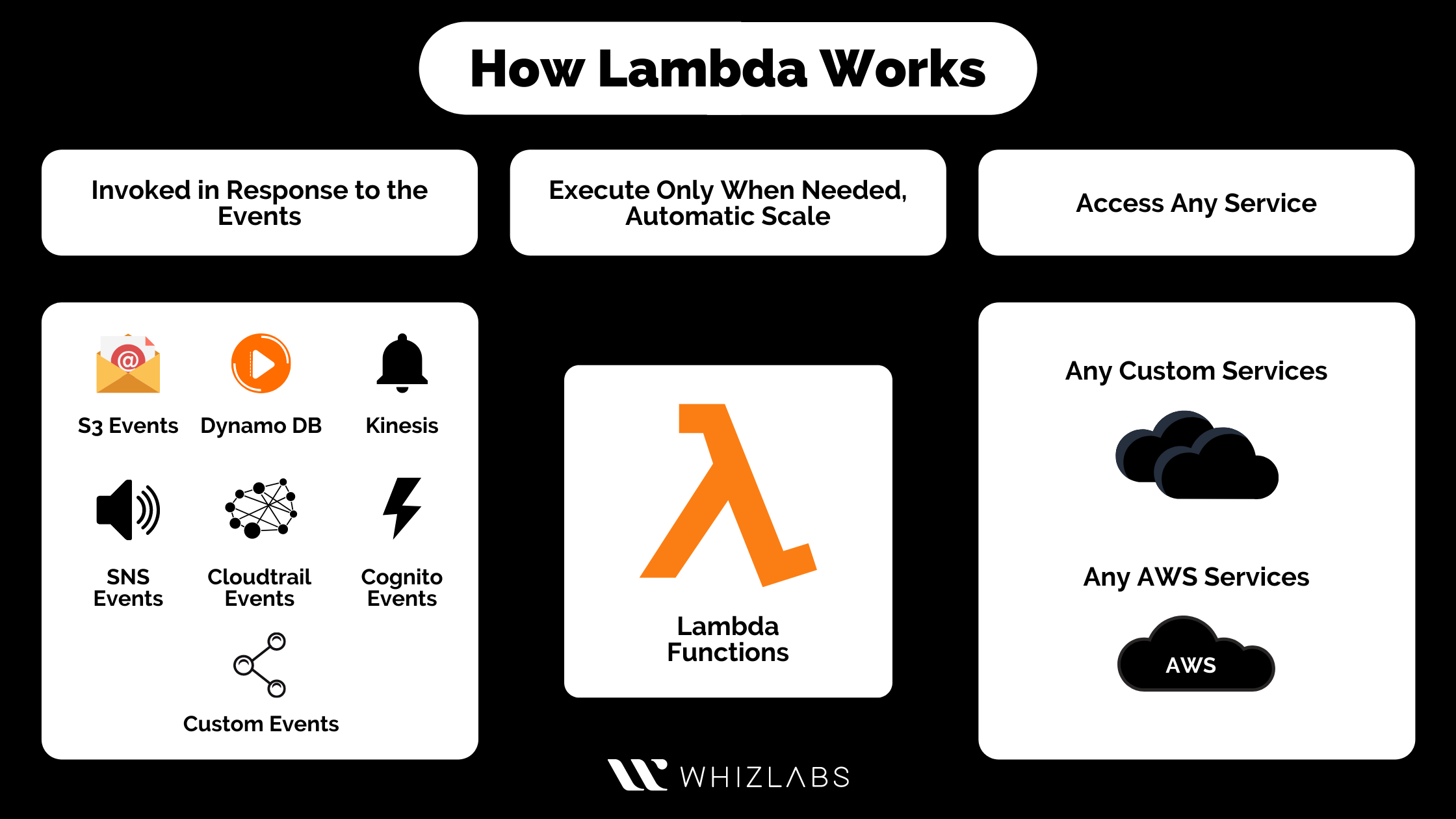AWS Lambda is a computing service that allows you to run the prepared codes without the necessity of managing or provisioning servers. Lambda is destined to run your code only when it is highly needed and further scales it automatically. AWS Lambda is chargeable, and it bills you for the compute time consumed by you and does not charge you anything while your code is stationary.
AWS Lambda allows you to run the codes virtually for almost all types of applications and back-end services. The infrastructure of AWS Lambda upon which it runs your code is destined to give an optimal response. Along with that, it performs all of the administration operations such as computing the resources, OS maintenance, server maintenance, automatic scaling, capacity provisioning, code monitoring, and others. The only thing you need to do is put up your code in a Lambda understandable language.
This article intends to give you a brief guide on what AWS Lambda is and help you understand the detailed attributes.
Features of AWS Lambda
The serverless compute service AWS Lambda has impeccable features to run your code and manage the resources for you. Apart from that, the users can also use AWS Lambda with other AWS services based on the customized logic. These perks are just like a glass of water poured into an ocean! There are more features to add to this guide that are as follows:
1. Building Customized Back-End Services
AWS Lambda is highly preferred for creating back-end services for the dedicated applications that are usually triggered on specific demands. These applications are triggered with the use of custom or Lambda API endpoints that are developed or built upon the API gateway of Amazon. With the use of this feature offered by Amazon Lambda, you can be sure of adapting easier updates, reducing battery drain, and avoiding client platform variations.
2. Automated Administration
The infrastructure upon which AWS Lambda runs your code is fault-tolerant and highly available. Due to this feature implementation, you can free up your efforts to put it for building back-end services. The automated administration feature of AWS Lambda allows you to take off the hassle of updating the OS patch manually as AWS Lambda handles it for you.
Apart from that, it automatically adds new servers when it measures growth in your usage rate. It deploys your code and handles all the administration and maintenance jobs seamlessly. Along with that, it also updates the security patches and is integrated with Amazon CloudWatch for providing logging and monitoring services.
Here we bring a comprehensive AWS Lambda tutorial that will make you a pro in AWS Lambda.
3. Fault-Tolerance
It is yet another best feature of AWS Lambda that protects your code under the instances of data center or machine failures. AWS Lambda does this by maintaining the computing capacity at optimal levels across different availability zones of diverse regions. Amazon Lambda consists of no scheduled downtime or maintenance closures. Therefore, you can expect seamless execution of your codes with it.
4. Automated Scaling Potential
AWS Lambda runs your code only when it is needed and called by you. And with that, it also automatically scales itself to support the incoming request rate. You do not need to tweak or modify the configurations for it, as Lambda would implement its necessary functions accordingly. There are no specified number limits upon AWS Lambda for handling the request counts.
These are some of the important features that were meant to be highlighted in brief for explaining to you the potential of Lambda AWS. There are many more features embedded within AWS Lambda to give you a better experience with it. The additional features include:
- It packages and deploys the functions as the container images help make it convenient for the customers to build applications upon AWS Lambda.
- AWS Lambda is embedded with Provisioned Concurrency for enabling you to possess control over how the serverless application performs. It keeps the functions in an initialized state to keep them ready for responding within milliseconds.
- AWS Lambda comes with an integrated model of security that makes the code accessible to other services offered by AWS securely.
- AWS Lambda bills you only for the compute time used for running the code and for the requests that are successfully served.
Best Performing AWS Free Tests
| Sl No | Certification | Questions | Rating | Link to the Test |
|---|---|---|---|---|
| 1 | AWS Certified Cloud Practitioner | 55 Practice Questions | 4.72 (29235) | Try Now |
| 2 | AWS Certified Solutions Architect Associate | 20 Practice Questions | 4.72 (93418) | Try Now |
| 3 | AWS Certified Developer Associate | 25 Practice Questions | 4.67 (29669) | Try Now |
| 4 | AWS Certified SysOps Administrator Associate | 20 Practice Questions | 4.69 (17143) | Try Now |
| 5 | AWS Certified Solutions Architect Professional | 15 Practice Questions | 4.71 (20740) | Try Now |
| 6 | AWS Certified DevOps Engineer Professional | 15 Practice Questions | 4.56 (10809) | Try Now |
| 7 | AWS Certified Advanced Networking – Specialty | 15 Practice Questions | 4.41 (3894) | Try Now |
| 8 | AWS Certified Security - Specialty | 15 Practice Questions | 4.49 (8650) | Try Now |
| 9 | AWS Certified Alexa Skill Builder - Specialty | 15 Practice Questions | 4.58 (972) | Try Now |
| 10 | AWS Certified Machine Learning - Specialty | 15 Practice Questions | 4.81 (3157) | Try Now |
| 11 | AWS Certified Database - Specialty | 15 Practice Questions | 4.67 (1005) | Try Now |
| 12 | AWS Certified Data Analytics - Specialty | 20 Practice Questions | 4.55 (2000) | Try Now |
Limitations Within AWS Lambda
AWS Lambda, released in 2014, has been adopted fast and is now a renowned serverless compute service. It is highly known for its highly functional architecture but has some limitations within the runtime environment that you should possess knowledge about. The limitations are as follows:
- The disk space or ephemeral has a maximum limit of up to 512 MB.
- The size of the default package of deployment is around 50MB.
- The memory range is limited with a window between 128MB to 3008MB.
- The maximum timeout of the execution limit is 15 minutes for any function.
- The payload size of the request & response body can be 6 MB at maximum. It is the limit for synchronous calls!
- The payload size for the event request body or asynchronous calls has a maximum limit of 128KB.
These are some of the limitations within AWS Lambda that you need to take concern while using it. You can go to the AWS Service Limits to raise support requests on your queries upon the default limits of Lambda.
Read more on AWS Lambda vs EC2!
Use Cases and Types of Applications Built upon AWS Lambda
The core components that are embedded within AWS Lambda for building applications are triggers and Lambda functions. A trigger is the AWS service meant for invoking a function. Lambda function is the ultimate code & runtime that is meant to process the operational events.
Some types of applications that can be built upon AWS Lambda are:
- File Processing- If you are building a photo-sharing app, then it should possess features as uploading photos, following which the photos are stored in the Amazon S3 bucket. The application should then create a thumbnail of the user photos to display it over the profile of respective users. Lambda function is embedded onto the app for automating the creation of thumbnails.
- Websites- If you are building a website or a web application, you should avail the functionality of holding the back-end logic on Lambda. For that, the lambda function needs to be invoked over HTTP using the API Gateway by Amazon as an HTTP endpoint. The web client is now permitted to invoke that API, after which the request will be passed onto Lambda.
- Mobile Apps- If you are building a custom mobile application for producing the events, the lambda function can be helpful for the same. Go ahead and create a dedicated Lambda function for processing the published events by your application.
Read more on When Should You Use AWS Lambda!
AWS Lambda supports several AWS services as a source of events. The above-mentioned application types on which AWS Lambda is integrated are destined to give high-end productivity and functionality. Apart from that, there are some use cases on which you need to direct your knowledge:
- It helps with the operation of serverless websites
- It supports rapid document conversion.
- AWS Lambda is adapted for its feasibility of working with external services.
- The backups and the administrative tasks are completely automated with the use of AWS Lambda.
- It is used for back-end cleaning.
- It can be implemented for real-time data processing.
These are some of the use cases that are popularly implemented with the use of AWS Lambda. It defines the efficacy of this serverless compute service platform.
Read a simplified AWS Lambda Documentation today!
Conclusion
With all of these detailed attributes highlighted above, you would have got the clarity upon how Lambda AWS is of utmost importance to help the users execute their codes, build applications, add specific functionalities and implement other such functions. If you are a beginner to AWS Lambda, then this article is the right pick for your initial assistance. Make sure you understand these AWS Lambda basics and how things work within them. For further knowledge, you can consider taking up online tutorials to master the practical implementations.
- Top 20 Questions To Prepare For Certified Kubernetes Administrator Exam - August 16, 2024
- 10 AWS Services to Master for the AWS Developer Associate Exam - August 14, 2024
- Exam Tips for AWS Machine Learning Specialty Certification - August 7, 2024
- Best 15+ AWS Developer Associate hands-on labs in 2024 - July 24, 2024
- Containers vs Virtual Machines: Differences You Should Know - June 24, 2024
- Databricks Launched World’s Most Capable Large Language Model (LLM) - April 26, 2024
- What are the storage options available in Microsoft Azure? - March 14, 2024
- User’s Guide to Getting Started with Google Kubernetes Engine - March 1, 2024


